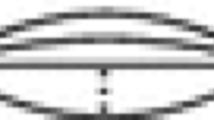Abstract
We show that there is a system of 14 non-trivial finitary functions on the random graph with the following properties: Any non-trivial function on the random graph generates one of the functions of this system by means of composition with automorphisms and by topological closure, and the system is minimal in the sense that no subset of the system has the same property. The theorem is obtained by proving a Ramsey-type theorem for colorings of tuples in finite powers of the random graph, and by applying this to find regular patterns in the behavior of any function on the random graph. As model-theoretic corollaries of our methods we rederive a theorem of Simon Thomas classifying the first-order closed reducts of the random graph, and prove some refinements of this theorem; also, we obtain a classification of the maximal reducts closed under primitive positive definitions, and prove that all reducts of the random graph are model-complete.
Similar content being viewed by others
References
F. G. Abramson and L. Harrington, Models without indiscernibles, Journal of Symbolic Logic 43 (1978), 572–600.
M. Bodirsky and H. Chen, Oligomorphic clones, Algebra Universalis 57 (2007), 109–125.
M. Bodirsky, H. Chen, J. Kára and T. von Oertzen, Maximal infinite-valued constraint languages, Theoretical Computer Science 410 (2009), 1684–1693. A preliminary version appeared at ICALP’07.
M. Bodirsky, H. Chen and M. Pinsker, The reducts of equality up to primitive positive interdefinability, Journal of Symbolic Logic 75 (2010), 1249–1292.
M. Bodirsky, P. Jonsson and T. von Oertzen, Horn versus full first-order: a complexity dichotomy for algebraic constraint satisfaction problems, Journal of Logic and Computation 22 (2010), 643–660.
M. Bodirsky and J. Kára, The complexity of equality constraint languages, Theory of Computing Systems 3 (2008), 136–158. A conference version appeared in the proceedings of CSR’06.
M. Bodirsky and J. Kára, The complexity of temporal constraint satisfaction problems, Journal of the ACM 57 (2009), 41 pp. An extended abstract appeared in the proceedings of STOC’08.
M. Bodirsky and J. Nešetril, Constraint satisfaction with countable homogeneous templates, Journal of Logic and Computation 16 (2006), 359–373.
M. Bodirsky and M. Pinsker, Topological Birkhoff, Transactions of the American Mathematical Society, to appear. Preprint arxiv.org/abs/1203.1876.
M. Bodirsky and M. Pinsker, Reducts of Ramsey structures, in Model Theoretic Methods in Finite Combinatorics, Contemporary Mathematics, Vol. 558, American Mathematical Society, Providence, RI, 2011, pp. 489–519.
M. Bodirsky and M. Pinsker, Schaefer’s theorem for graphs, in STOC’ 11—Proceedings of the 43rd ACM Symposium on Theory of Computing, ACM, New York, 2011, pp. 655–664. Preprint of the long version available at arxiv.org/abs/1011.2894.
M. Bodirsky, M. Pinsker and T. Tsankov, Decidability of definability, in 26th Annual IEEE Symposium on Logic in Computer Science—LICS 2011, IEEE Computer Society, Los Alamitos, CA, 2011, pp. 321–328. Preprint of full journal version available from arxiv.org/abs/1012.2381.
A. Bonato and D. Delić, The monoid of the random graph, Semigroup Forum 61 (2000), 138–148.
A. Bonato, D. Delić and I. Dolinka, All countable monoids embed into the monoid of the infinite random graph, Discrete Mathematics 310 (2010), 373–375.
A. A. Bulatov, A dichotomy theorem for constraint satisfaction problems on a 3-element set, Journal of the ACM 53 (2006), 66–120.
P. J. Cameron, Transitivity of permutation groups on unordered sets, Mathematische Zeitschrift 148 (1976), 127–139.
P. J. Cameron, Oligomorphic Permutation Groups, Cambridge University Press, Cambridge, 1990.
P. J. Cameron, The random graph, Algorithms and Combinatorics 14 (1997), 333–351.
P. J. Cameron, The random graph revisited, in Proceedings of the European Congress of Mathematics, Vol. 201, Birkhäuser, Basel, 2001, pp. 267–274.
D. Delić and I. Dolinka, The endomorphism monoid of the random graph has uncountably many ideals, Semigroup Forum 69 (2004), 75–79.
M. Goldstern and M. Pinsker, A survey of clones on infinite sets, Algebra Universalis 59 (2008), 365–403.
W. Hodges, A Shorter Model Theory, Cambridge University Press, Cambridge, 1997.
M. Junker and M. Ziegler, The 116 reducts of (ℚ,<,a), Journal of Symbolic Logic 74 (2008), 861–884.
J. Nešetřil and V. Rödl, Partitions of finite relational and set systems, Journal of Combinatorial Theory. Series A 22 (1977), 289–312.
J. Nešetřil, Ramsey theory, in Handbook of Combinatorics, Vol. 1, 2, Elsevier, Amsterdam, 1995, pp. 1331–1403.
J. Nešetřil and V. Rödl, Ramsey classes of set systems, Journal of Combinatorial Theory. Series A 34 (1983), 183–201.
J. Nešetřil and V. Rödl, The partite construction and Ramsey set systems, Discrete Mathematics 75 (1989), 327–334.
M. Pinsker, More sublattices of the lattice of local clones, Order 27 (2010), 353–364.
R. Pöschel and L. A. Kalužnin, Funktionen- und Relationenalgebren, Ein Kapital der diskreten Mathematik, Mathenatische Monographien, Vol. 15, Deutscher Verlag der Wissenschaften, Berlin, 1979.
T. J. Schaefer, The complexity of satisfiability problems, in Conference Record of the Tenth Annual ACM Symposium on Theory of Computing (San Diego, CA, 1978), ACM, New York, 1978, pp. 216–226.
Á. Szendrei, Clones in Universal Algebra, Séminaire de Mathématiques Supérieures, Vol. 99, Presses de l’Université de Montréal, Montréal, QC, 1986.
S. Thomas, Reducts of the random graph, Journal of Symbolic Logic 56 (1991), 176–181.
S. Thomas, Reducts of random hypergraphs, Annals of Pure and Applied Logic 80 (1996), 165–193.
Author information
Authors and Affiliations
Corresponding author
Additional information
The research leading to these results has received funding from the European Research Council under the European Community’s Seventh Framework Programme (FP7/2007-2013 Grant Agreement no. 257039). The second author is grateful for support through Erwin Schrödinger Fellowship J2742-N18 of the Austrian Science Fund and through an APART-fellowship of the Austrian Academy of Sciences.
Rights and permissions
About this article
Cite this article
Bodirsky, M., Pinsker, M. Minimal functions on the random graph. Isr. J. Math. 200, 251–296 (2014). https://doi.org/10.1007/s11856-014-1042-y
Received:
Revised:
Published:
Issue Date:
DOI: https://doi.org/10.1007/s11856-014-1042-y




